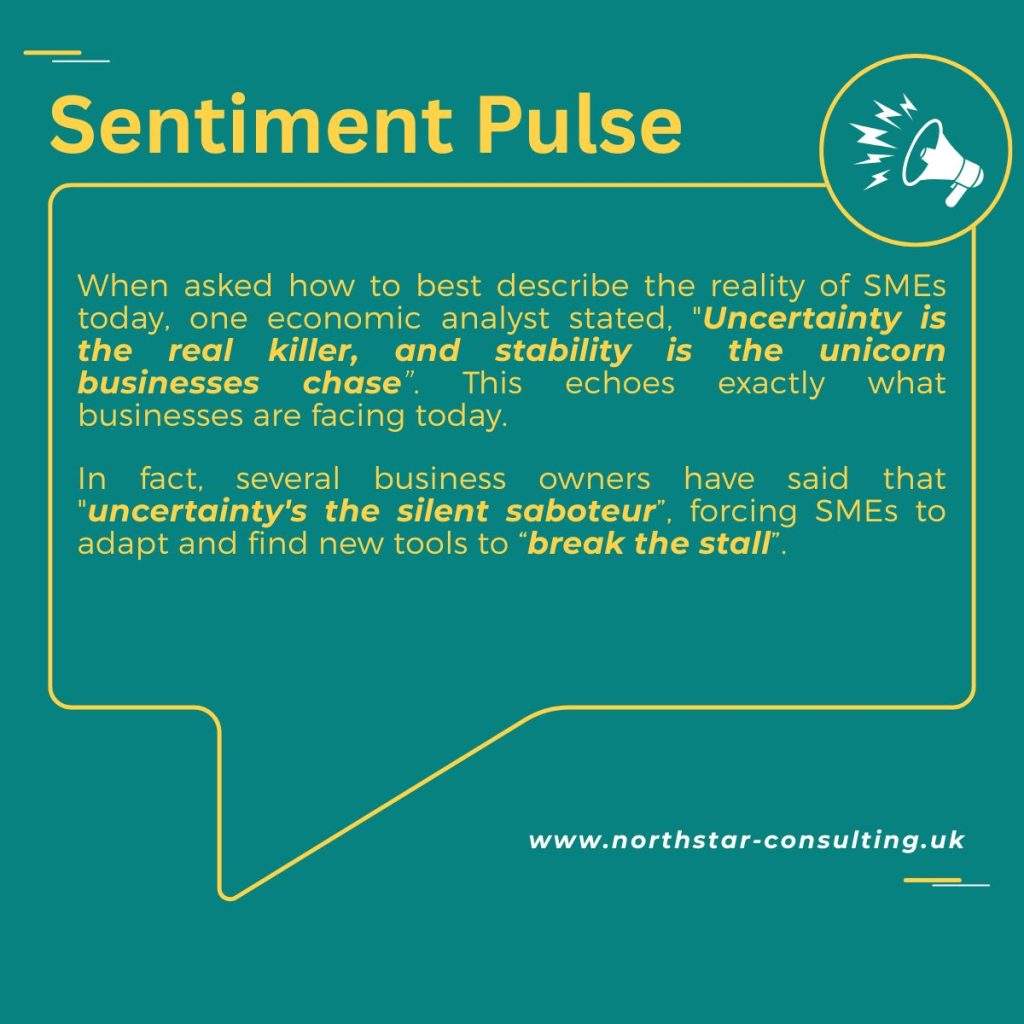This article is Part 2 of our series “Trade Winds 2025”, where we explore how shifting trends in trade impact the global economy and business around the globe.
You can find the first article, Shifting Trade Winds: What Next for SMEs?, on The Pulse, our dedicated research and insights hub.
EU Trade Trends
Over the past two years, Europe’s trade narrative has shifted quietly, then suddenly. After a shaky recovery from the pandemic, 2023 gave way to a cooler 2024. Imports fell by about 3.4% while exports edged up by roughly 1.1%, leaving the EU with a goods surplus of approximately €147 billion in 2024. At first glance, that looks like good news, yet it was a headline born of timing and composition rather than broad strength.
By 2025, the pattern became more obvious. Firms pushed shipments forward into the first quarter, anticipating tariff changes and policy noise, which created a temporary spike. In the second quarter, the effect unwound. Exports fell by around 3.4% and imports dropped about 7.1%, shrinking the surplus from roughly €55 billion in Q1 to about €26 billion in Q2. The message is clear: volatility has replaced steady recovery, and the swings are now large enough to matter to small firms.
Beneath these shifts lies a deeper concern. Export volumes remain below pre-2020 levels, and the EU has lost meaningful ground in global market share. The pie is no longer expanding at its old pace, and competitors are claiming bigger slices. Geography still defines outcomes: the United States remains the EU’s largest export market, China is the main source of imports, and intra-EU trade continues to dominate commercial flows. Sector performance also diverges. Machinery, vehicles and chemicals show resilience, while energy and raw material imports remain a persistent drag.
Europe’s trade picture is more fragile than the headline surpluses suggest. Temporary surges in shipments and uneven sector performance have replaced the smooth rebound once expected. The EU is holding ground with established partners, but its relative share of global trade is slipping. For exporters, this means adjusting to an environment of shorter cycles, sharper swings and tougher competition, where resilience and speed now matter as much as scale.
UK Trade Trends
The UK’s trade picture has been steady in one sense and unsettled in another. The headline is familiar. In 2024, total exports of goods and services reached about £873 billion, while imports were roughly £906 billion, leaving a goods deficit of about £226 billion, partly offset by a services surplus of £194 billion. The EU remains central to that story. Around 45% of UK exports and half of its imports still flow to and from the single market. These are big numbers, and they shape strategy for most firms.
Look closer, and the pattern is more jagged. In the first half of 2025, firms moved early, shipments bounced, then activity cooled. By the three months to July, the headline trade deficit narrowed slightly to about £14.8 billion from £15.0 billion. That sounds comforting, yet the detail is less so. Over the quarter, UK goods exports fell around 1.8% while imports rose 0.9%, widening the underlying goods gap to roughly £61.9 billion. Exports to non-EU markets proved weak, while sales to the EU showed small gains. July did bring a rebound, with both exports and imports rising, but monthly spikes do not erase a structural story.
UK exporters face subdued global demand and stiff competition. If exports are not growing much, businesses must rely on carving out niche markets or boosting domestic and services sales. The data suggest UK firms remain most active in EU trade, reflecting geography and existing supply chains, but stronger growth outside the EU is needed to narrow the persistent deficit.

SME Exporters and Business-Level Data
Small and medium-sized enterprises dominate Europe’s business landscape, yet their role in trade remains modest. In the UK, only about 17% of SME employers exported goods or services in 2024, down from pre-2020 levels. The larger the firm, the greater the likelihood of selling abroad: around 30% of medium-sized businesses exported, compared with just 16% of micro firms. Even among those that do export, the EU remains the natural focus. Roughly 77% of UK SME exporters sold into EU countries in 2024, compared with 71% into non-EU markets. For most, exports remain a sideline, with 60% of SME exporters reporting that overseas sales account for less than a quarter of turnover. The implication is clear: for the minority that succeeds, international growth can transform revenue streams.
Across the EU, the pattern repeats on a larger stage. Eurostat data show that SMEs (firms with fewer than 250 employees) make up around 95% of all exporters by number but account for a minority of the value. In intra-EU trade, SMEs represented 96.9% of exporters yet generated only 39.4% of export value, while the 3.1% of large firms captured 60.3%. In extra-EU trade, the imbalance is even starker: SMEs contributed just 29.4% of export value, with large firms producing over 70%. Put simply, the many small firms carry the numbers, but the few big players capture the lion’s share of the money.
These firm-level figures connect directly to the wider trade story. When global demand slows or tariffs rise, SMEs lacking the networks and buffers of multinationals tend to retreat first. Recent surveys confirm that the share of UK and EU SMEs reporting export declines has ticked up. For policymakers, the message is urgent: if Europe is to revitalise trade, it must help its SMEs scale across borders. That means reducing frictions, making finance and logistics more accessible, and strengthening regional supply chains. SMEs may account for a smaller slice of trade today, but they remain vital to jobs, innovation and resilience. A true turnaround in exports will depend as much on enabling these smaller firms as on helping multinationals navigate shifting global currents.

Fragility Now, Structure Tomorrow
The trade environment facing the UK and the EU has split into two distinct horizons. The short term is fragile, shaped by weaker demand, tariffs and policy moves that have already dented momentum in 2025. The medium term is structural, marked by rising unpredictability in the rules of the game. Policy uncertainty has become the hidden cost of trade, translating into delays, higher financing charges and a more volatile playing field. For SMEs, with thinner margins and smaller buffers, the consequences are magnified.
This new pattern means that occasional shocks are now compounded by persistent frictions. Freight routes are lengthening, shipping and insurance costs are rising, and firms that rely on single suppliers or narrow export markets face higher logistics friction and payment risks. Recent analysis has highlighted growing volatility in global supply chains, with tariffs and geopolitical pressure accelerating the trend.
The UK is no exception. Trade data through mid-2025 shows exports and imports moving in opposite directions month to month, underlining how quickly SMEs can be exposed when volumes shift against them. The EU, meanwhile, expects modest growth through 2025, but Brussels has already warned of downside risks if global conditions worsen. That caution is well-placed. Many SMEs sit inside manufacturing supply chains or service export networks, where a weaker trade backdrop bites first.
Building for Storms, Not Calm Seas
The message from the data is clear: UK and EU trade is no longer defined by steady recovery but by swings that test even the most resilient firms. For SMEs, this means facing volatility head-on. The old playbook of scale, single suppliers and deferred investment in visibility no longer works. What once saved pennies now destroys pounds.
Policy choices in Westminster and Brussels will shape the competitive ground for years to come. Trade measures, industrial strategies and tariff shifts ripple quickly through supply chains, and the impact is felt first and hardest by smaller firms. Tracking these changes is no longer a back-office task; it is now a central part of leadership strategy.
The conclusion is simple but urgent. Volatility is not a passing phase; it is the new normal. The firms that thrive will be those that build for storms, not those that wait for calm seas.
Global trade is not collapsing, it is being reorganised. That is manageable. For UK and EU SMEs, the best response is to be selective, local and visible. Resilience in supply chains can become a differentiator, and a regional opportunity can be the launchpad for the next wave of growth.




